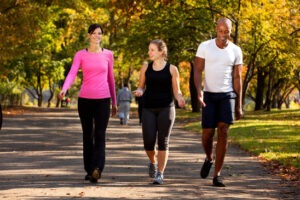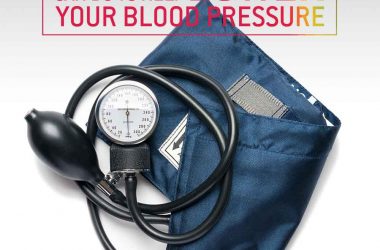Exercise Guidelines: What is right for you?
Since May is National Physical Fitness and Sports Month, we are sharing current exercise guidelines for adults provided by the American College of Sports Medicine (ACSM), the nation’s foremost professional society dedicated to the study and advocacy of the benefits of exercise.

There is strong scientific evidence demonstrating numerous health benefits of exercise. These include delayed mortality from all causes; decreased risk of heart disease, stroke, type 2 diabetes, and colon and breast cancers; lower blood pressure; improved cholesterol profile and inflammatory markers; improved insulin sensitivity; preserved bone mass and reduced risk of falling; improved energy and mental health; and lower risk of cognitive decline and dementia.
It should be noted, however, that for the purpose of losing weight, research shows that proper diet plays a much more critical role than exercise.
For general health benefits, the ACSM recommends that adults engage in a program of regular exercise training, beyond the activities of daily living, which includes four different types of exercise. These are:
- Cardiorespiratory exercise
- Resistance exercise
- Flexibility exercise
- Neuromotor, or functional fitness training
The first type, cardiorespiratory (aerobic) exercise includes activities such as walking, treadmill, elliptical, cycling, spinning, recumbent bicycle, swimming, water aerobics, dancing and rowing. Jogging, running and racquetball are also examples, but these and any other high-impact activities are discouraged for overweight or obese persons because of the increased risk for knee and hip injuries. You should select whichever activity you enjoy and can stick with, and be certain to listen to your body: if it hurts, don’t do it!
If you are not accustomed to exercise, you should start slow and gradually build up to at least 150 minutes per week (e.g. 30 minutes a day, 5 days a week) of moderate-intensity exercise. Alternatively, you can build up to at least 75 minutes per week (e.g. 25 minutes a day for 3 days a week) of vigorous-intensity exercise. You can also do a combination of the two, for a total energy expenditure of at least 1000 calories per week (most modern exercise equipment will estimate your caloric expenditure during the session.)
How do you determine moderate- vs. vigorous-intensity? For moderate-intensity, your heart rate in beats per minute should be 55-69% of its estimated maximum (220 minus your age); for vigorous-intensity, it should be above 70%. A simpler method is to use the “talk test”. For moderate-intensity, you should be able to converse with some effort while for vigorous-intensity, you should be unable to say more than a few words without pausing for a breath. If time is a barrier, multiple sessions of 10 minutes can be accrued to meet the recommended daily duration. And bear in mind that ANY amount of exercise is better than none!
Some important caveats: Although regular exercise leads to the many health benefits mentioned above, there is a transient increase in the risk of heart disease and musculoskeletal injuries at the beginning of an exercise program if you are not accustomed to physical activity. Walking and moderate-intensity activities are associated with a very low risk of musculoskeletal injuries. Heart attack and sudden cardiac death, however, can be triggered by unaccustomed vigorous exercise, particularly in sedentary persons with unrecognized or known heart disease. If you have two or more risk factors for heart disease (men older than 45, women older than 55, regular smoking within the past six months, sedentary for previous three months, obesity, high blood pressure, high cholesterol, pre-diabetes or diabetes), you should consult your doctor before engaging in vigorous-intensity exercise. A stress test may be recommended prior to starting your program. If you have known heart or lung disease, you should consult with your doctor prior to engaging in any exercise program. And everyone should be aware of the warning signs of a heart attack, which include chest pain or tightness that may radiate down the arm, unusual shortness of breath with exertion, or feeling faint. Although exercise is safe and beneficial for the vast majority of people, you should always listen to your body!
The time durations mentioned previously (75 minutes per week of vigorous-intensity exercise or 150 minutes per week of moderate-intensity exercise) are for general health benefits. For active weight loss, studies show that more is needed, with a dose effect: 150-225 minutes per week to lose 4.4-6.6 lbs, 225-420 minutes per week to lose 11-16.5 lbs. For persons who have lost a substantial amount of weight (e.g. 30-50 pounds), the requirements for keeping the weight off are high as well: 300-420 minutes per week. (I hate to be the bearer of difficult news, but this is what the long-term research shows!) The reason for this is that the body’s “set point” for energy balance never returns to where it was when you were young and lean, so you have to work harder to keep the weight off. As mentioned earlier, research demonstrates that diet plays a stronger role in losing weight than exercise, but once you have lost a substantial amount of weight, exercise becomes increasingly important in order to keep it off.
For a discussion on the remaining three types of exercise, stay tuned! We will feature this information in our next weekly email.
References:
American College of Sports Medicine position stand. Quantity and quality of exercise for developing and maintaining cardiorespiratory, musculoskeletal, and neuromotor fitness in apparently healthy adults: guidance for prescribing exercise. Med Sci Sports Exerc. 2011; 43(7): 1334-59.
American College of Sports Medicine position stand. Appropriate physical activity intervention strategies for weight loss and prevention of weight regain for adults. Med Sci Sports Exerc. 2009; 41(2): 459-471.
Exercise guidelines for overweight and obese patients. Online article by Maile Apau Jachowski, MD. Accessed August 30, 2015.
Physical Activity. Lecture by Deborah Bade Horn, DO, MPH, FASBP. Obesity Medicine Certification Review Course, American Society of Bariatric Physicians, September 2014, Austin, TX.
Schuler, L., & Cosgrove, A. (2009). The new rules of lifting: six basic moves for maximum muscle. New York, NY: Penguin Group.






